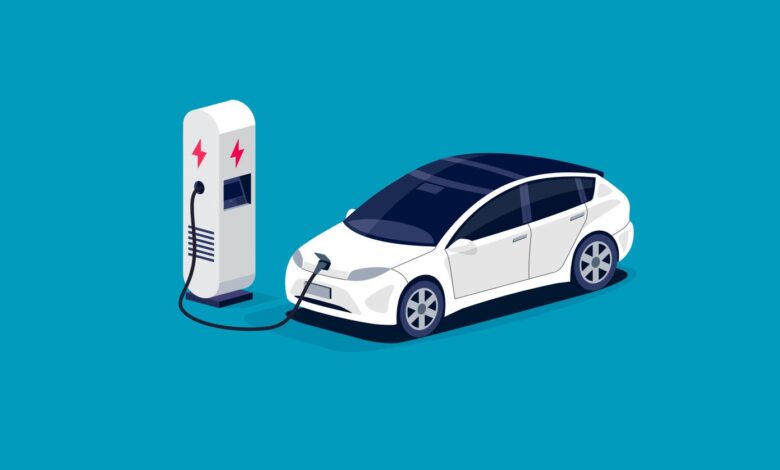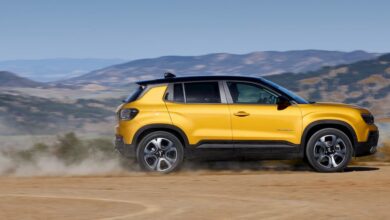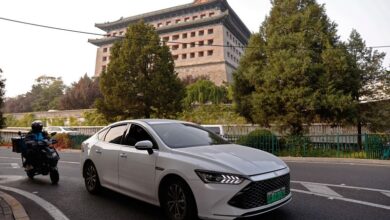The Two Faces Of EVs; Brilliant In Town, Hopeless In The Fast Lane

Modern electric car charging parking at the charger station with a plug in cable. Isolated flat … [+]
Electric vehicles are mainly overpriced city cars, fine for local use but hopeless if you plan a long trip on fast motorways.
Next-generation solid-state technology batteries promise to half the price, weight and cost, and double the range. But until solid-state arrives, and this seems unlikely in any great numbers until at least 2030, EVs will remain the unfinished article.
Meanwhile, European car buyers are being effectively gaslit by a lack of detailed information about the EVs they are being persuaded to buy. Not only is official range information often seriously exaggerated. An important negative is deliberately omitted; the fact that high but legal autoroute cruising slashes range by between 30 and 60%.
EV buyers need honest data which should include a rating of fast-lane performance.
ACEA, the European Automobile Manufacturers’ Association, known by its French acronym, was asked to comment on the quality of range data in general and the possibility of a motorway performance rating but declined to reply.
Europe’s auto industry needs to acknowledge the unique qualities of electric cars, understand how the world of motoring will change, and produce EVs that fit the mold. If Europeans don’t do it, the Chinese are poised to do just that.
EVs won’t be hugely expensive internal combustion engine car wannabes with massive batteries. Think turbo-charged golf carts with windows. These new EVs will be practical and affordable (€12,000/$13,000 after tax) but with limited utility, like the BYD Seagull or Wuling Bingo. They will be perfect for the school run, the shopping trip, and the local commute. They won’t be able to blast down the autoroute to the sun. That’s impossible with current EV technology anyway. When this happens, any arguments about long-range will end simply because the electric revolution will essentially be local.
My reviews of more than 30 EVs over three years show as soon as speeds advance past 60 mph, the range drops away alarmingly. This is simply the laws of physics in action, as expressed by Peter Wells, Professor of Business and Sustainability at Cardiff Business School.
BYD Seagull
“Range falls off a cliff at high speed. For an electric car, the extra energy required getting from 60 mph to 75 mph is astonishing and virtually doubles energy consumption to move all that air out of the way,” Wells has said.
This range argument has been the elephant in the room for years. Back in 2012 when I questioned Elon Musk at the Geneva car show, he confirmed that Tesla average range claims were measured at 55 mph. It doesn’t much imagination to realize cruising at 75 mph is going to slash range.
EV range at autoroute cruising speeds is cut often by between 30% and 60%. This means that if the offered range is 100 miles, if you venture into the fast lane that will be cut by between 30 to 60 miles. This data is very conservative because it takes no account of official advice never to fill the battery beyond 80% of capacity. Extreme hot or cold temperatures aren’t considered, even though they can seriously debilitate battery charging capacity.
Manufacturers’ battery capacity range claims based on official EU Worldwide Harmonised Light Vehicle Test Procedure (WLTP) data are often grotesque exaggerations. For instance, my recent review of Hyundai’s Ioniq 6 shows a WLTP claim of 384 miles of range for the battery. In real-world reality, the battery capacity was only a theoretical average of 270 miles. Honda claims, loudly and often over British commercial radio, that its new e:NY1 will provide range up to 256 miles, but average recharging amounted to 162 miles.
Wuling Bingo (Photo by VCG/VCG via Getty Images)
Long-distance EV travel at fast legal speeds promises massively extended and inconvenient journey times compared with ICE vehicles.
An automotive industry expert who wishes to remain anonymous undertook journeys totalling 2,450 miles across French autoroutes in a Tesla Model X last year with two colleagues, which he compared to a Range Rover diesel. Most of the mileage was undertaken at average legal speeds between 130 to 140 km/h (80 to just under an indicated 90 mph).
One 1,550-mile trip was from Dieppe to Bordeaux, on to Marseilles then returning to the Channel tunnel at Calais. A second 900-mile trip was the Channel Tunnel to Paris, Nantes, then back to Calais.
The 450-mile Dieppe to Bordeaux leg required 3 charging stops, which the Range Rover diesel’s 550-mile range could have managed without stopping. Bordeaux to Marseilles over 400 miles required two stops versus none. Marseilles to the Channel Tunnel’s almost 700 miles needed four stops (versus one for the diesel). The Channel tunnel/Paris/Nantes/Channel Tunnel journey needed six stops versus two.
Tesla says the range of the Model X is up to 350 miles, but at these high speeds, recharging was necessary about once every 160 to 170 miles.
The Tesla’s range wasn’t helped by the need to make sure the battery capacity didn’t fill up past 80%. The Tesla charging infrastructure was impressive, as was the Model X’s charger locater. But charging wasn’t always found on the autoroutes but in retail parks or hotels. This caused much wasted time. The Range Rover diesel option would have given more flexibility and reduced journey times significantly, according to the auto expert.
Tesla Model X.
There is a wide choice of diesel vehicles costing much less than half the price of a Range Rover or Tesla Model X which could easily do 550 miles at motorway speeds and carry three people in comfort.
Why is this a surprise to EV buyers?
When car companies launch new vehicles to the media in Europe, they often fly them to locations where the climate will be conducive to photography. The cars are all filled to the brim for a typical four-hour drive to a hotel. Next day, the cars will be refuelled by the hosts, and driven back to the airport. The journalists will have much information about many aspects of the car, except the ability to monitor fuel consumption in any meaningful way, such as filling it with gasoline or plugging it in.
Carmakers also lend new vehicles to the media for about a week. Traditionally, this means the car will be delivered with a full tank of gasoline, diesel or a full battery. The press vehicles are often returned close to empty. This explains why most reviews of vehicles in the main-stream media regurgitate the fuel efficiency claims of the manufacturers because refilling, and paying for the contents, rarely takes place. When most vehicles were of the ICE variety, this allowed manufacturers to claim fuel efficiency often 30% or more better than real-world reality. In the EV world the same conditions apply, with almost no acknowledgement of the huge hole fast motorway cruising creates in range claims, or the dishonest nature of battery capacity claims.
Because many mainstream journalists don’t have home chargers, they never find out details like the Ioniq6 WLTP claim of 384 miles had to be compared with the fact the battery often wouldn’t take more than an average charge of 270 miles. Or that the autoroute high-speed penalty would be 38%, limiting the range to just under 170 miles.
Cupra Born (Photo by Sjoerd van der Wal/Getty Images)
A cynic might say the media process was designed to hide facts about real-world economy.
My review last year of the Cupra Born sums up the Dr Jekyll and Mr Hyde nature of most modern EVs. The Cupra is a subsidiary of Volkswagen, and the Born has much in common with the VW ID.3. On a 73-mile trip over rolling Sussex, Surrey and Hampshire country roads at speeds rarely over 50 mph and never over 60 mph, the Born used only 53 miles, thanks to its amazingly efficient regenerative braking technology. A longer but much faster 86-mile return trip using the M3 and M27 motorways removed 129 miles from the available battery range.
Until the technology improves EVs offer honest and able urban use, but questionable and unreliable high-speed performance. Carmakers must be persuaded by the EU to offer more transparent and comprehensive data to the public about the likely range-ability of their prospective EV.
This range argument is likely to die on the vine as cheap, utility EVs are sold in big numbers to help the market grow in Europe from the current 2 million to nearly 9 million by 2030. Given that large numbers of long-distance EV journeys won’t be possible physically, the next question is – will the authorities allow rented diesels to carry the occasional long-distance burden?



